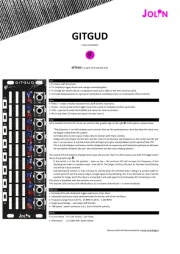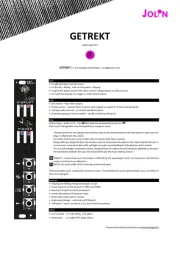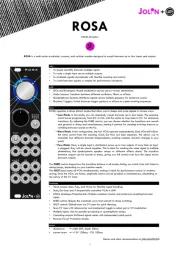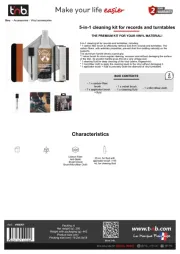Jolin Tabor Handleiding
Jolin
Niet gecategoriseerd
Tabor
Bekijk gratis de handleiding van Jolin Tabor (1 pagina’s), behorend tot de categorie Niet gecategoriseerd. Deze gids werd als nuttig beoordeeld door 52 mensen en kreeg gemiddeld 4.5 sterren uit 26.5 reviews. Heb je een vraag over Jolin Tabor of wil je andere gebruikers van dit product iets vragen? Stel een vraag
Pagina 1/1

TABØR
rhythmic oscillator
TABØR is an analogue chaotic source based on the unpredictability of four avalanche transistors.
why
• To create complex rhythmic textures tame them with external CV. and
• To explore sonically a unpredictable and chaotic audio source. n
• To organically modulate another oscillator.
• To make it scream and embrace the noise.
with
• Other oscillators as a FM modulation source. –
• Resonators starve the oscillators and create burst of noise to feed them. –
• Lush reverbs let it drone. –
• LFOs modulate all its 9 CV inputs. –
how
The principle behind ese oscillators is the th transistor reverse avalanche effect1.
The result of the FM cross modulation of the whole sound engine is chaotic.
Each oscillator identified with its color and acts differently in relation to the others: is
OSC1 –Green. Percussive and predominant, the fundamental modulator.
OSC2 Yellow. Follows rhythmically as a carrier. –1
OSC3 –Red. Strictly related to OSC2 but can set-aside 1 as a modulator2.
OSC4 –Orange. Act as a shutter to filter or interrupt the whole communication.
RM oscillators power starve input. –
Outputs:
TR –a rectified always positive 0-7v sourceCV 3.
NM – the main audio signal straight out of the oscillators.
ZZ – filtered output from the internal diode-based distortion circuit. an auxiliary fuzzed
features
• Four avalanche oscillators with frequency pulse and cross-modulation controls.
• CV inputs on all the parameters.
• Starve input to restrict the amount of power supplied to the oscillators.
• Color-coded LEDs provide clear visual reference for the state of each oscillator. to
• Three outputs: TR for gates, NM for audio, and ZZ for a smoothed fuzz output.
• Reverse power protection.
specs
• current draw +12V 140 , -12V 40 ma ma
• dimensions width HP, depth mm 12 25
Demos and build documentation at jolin.tech/tabor
1 A capacitor is charged via a current limiting resistor. When the voltage across the capacitor reaches a specific threshold, the transistor enters its avalanche breakdown mode and start exhibits negative resistance (i.e., the
higher the current, the lower the resistance). The capacitor then discharges rapidly through the LED and the voltage across drops until the avalanche mode can no longer be sustained. At this point, the transistor stabilizes and
becomes non-conductive again. Thus, the cycle continues. The rapid discharging through the LED manifests itself as short blinks. More info and acknowledgement:
Kerry D. Wong, BJT In Reverse Avalanche Mode http://www.kerrywong.com/2014/03/19/bjt- -reverse-avalanche-mode at in
2 otentiometers. Its values can be changed only with external CV inputs.Due to its autonomy from the fundamental OSC1 and to keep the communication balanced, OSC3 it’s missing the F and M control p
3 This output is not always active, it fires gates when the avalanche engine reaches a certain threshold blue LEDs blinking –
Product specificaties
| Merk: | Jolin |
| Categorie: | Niet gecategoriseerd |
| Model: | Tabor |
Heb je hulp nodig?
Als je hulp nodig hebt met Jolin Tabor stel dan hieronder een vraag en andere gebruikers zullen je antwoorden
Handleiding Niet gecategoriseerd Jolin

13 Juni 2025

3 Juni 2025

2 Juni 2025

3 Augustus 2023

3 Augustus 2023

3 Augustus 2023

3 Augustus 2023

3 Augustus 2023

1 Juli 2023

22 Juni 2023
Handleiding Niet gecategoriseerd
- Gallien-Krueger
- Shuttle
- Waltec
- Nature2
- Audeze
- RugGear
- Twin Eagles
- Paraclipse
- DEXP
- ECTIVE
- G3
- Bernina
- Maximum
- Winston
- Dual
Nieuwste handleidingen voor Niet gecategoriseerd

13 September 2025

13 September 2025

13 September 2025

13 September 2025

13 September 2025

13 September 2025

13 September 2025

13 September 2025

13 September 2025

13 September 2025